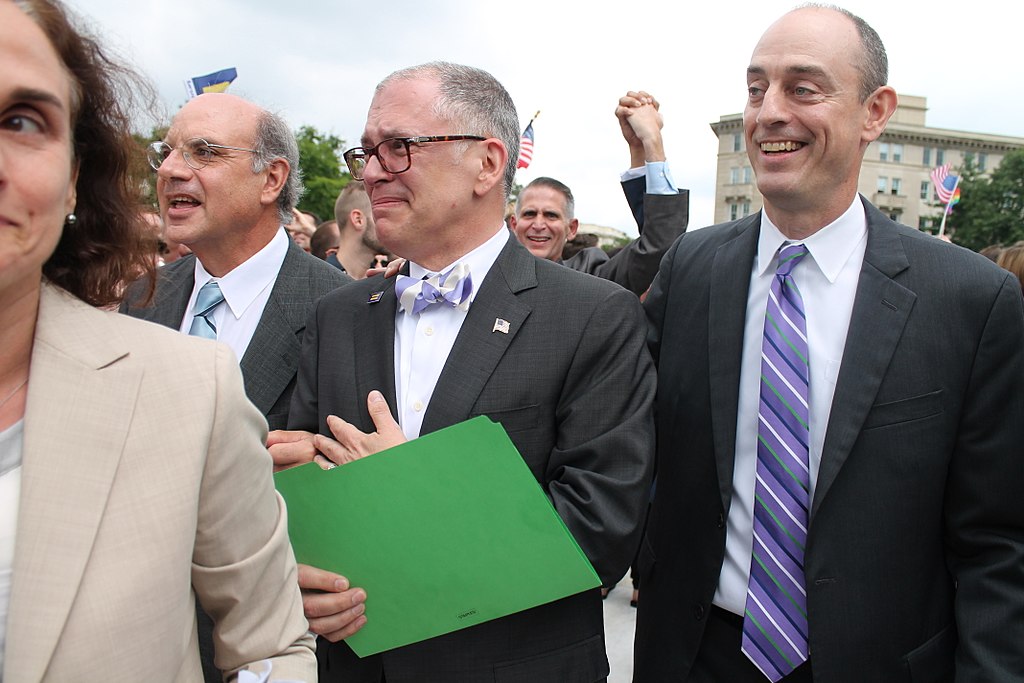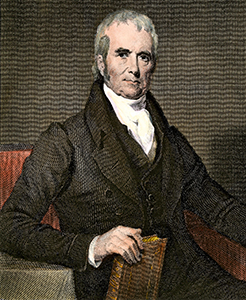Outside the Supreme Court on June 26, 2015.
Pop Civ 11: Marriage Equality and June 26
Introduction
As the end of June draws near, we’re looking back at some late-June decisions that were handed down at the end of the Supreme Court term in 2003, 2013, and 2015. The three cases we will examine all shaped access to equality for the LGBTQ community: Obergefell v. Hodges, United States v. Windsor, and Lawrence v. Texas. Serendipitously, the three cases also all had their decisions announced on the same date, June 26.
In addition to each of these cases’ individual merit, the three together chart a path towards the eventual end of same-sex marriage bans in the nation and the legalization of gay marriage.
The Path to Marriage Equality
Our first case, Lawrence v. Texas, was decided in 2003 and involved the decriminalization of “homosexual conduct,” as it was called at the time. In 1998, while responding to a report of a weapons disturbance at Houstonian John Lawrence’s apartment, police entered Lawrence’s home and discovered Lawrence and Tyron Garner engaged in a private, consensual intimate act. The two men were arrested and charged in violation of Texas’s “Homosexual Conduct” law.
Local Harris County Criminal Court denied Lawrence’s and Garner’s efforts to dismiss the charges against them for being unconstitutional, and the pair eventually plead “nolo contendere” to the charges. This allowed them both to continue their pursuit of a constitutional challenge to the law they were accused of breaking.
By 2000, Lawrence and Garner had their convictions overturned by the 14th Court of Appeals and were supported in their challenges by Lambda Legal, the nation’s oldest legal organization focused on supporting LGBTQ rights. In 2001, a larger panel of the Texas Court of Appeals overturned the appellate court’s decision, citing a 1986 Supreme Court decision, Bowers v. Hardwick, which narrowly decided that there was no constitutional protection for specific intimate acts between consenting adults. As a result, Lawrence and Garner’s earlier convictions were upheld.
In 2002, Lambda Legal asked the Supreme Court to review the case, offering two new constitutional challenges to Texas’s “Homosexual Conduct” law. They claimed the law violated the Equal Protection clause of the 14th amendment, and that it violated constitutional rights to privacy and liberty. At the heart of this challenge was that the assertion that the Texas law criminalized sexual intimacy by same-sex couples but not identical behavior by different-sex couples. The Court decided to hear the case in December of that year with oral arguments before the Court in March of 2003.
Attorney Paul Smith, with Lambda Legal Defense Fund attorney Ruth Harlow on his right, after arguing the case before the Supreme Court, 2003.
On June 26, 2003, a 6-3 opinion was delivered by Justice Kennedy in favor of the plaintiffs, with Justices O’Connor, Stevens, Ginsburg, and Breyer in support of the decision. Chief Justice Rehnquist was joined by Justices Thomas and Scalia in a dissent of the opinion. The Court held that the Texas statute at issue did, in fact, violate the Due Process clause of the 14th Amendment. In the majority opinion, Kennedy wrote that,
“[The plaintiffs’s] right to liberty under the Due Process Clause gives them the full right to engage in their conduct without intervention of the government … The Texas statute furthers no legitimate state interest which can justify its intrusion into the personal and private life of the individual.”
Next, we turn to United States v. Windsor, the case that struck down the 1996 Defense of Marriage Act (DOMA). DOMA stipulated that, under federal law, “marriage” and “spouse” could only refer to unions between a man and a woman, excluding same-sex couples from those federal protections. Shortly following the passage of that law in 1996, states around the nation began to legalize same-sex marriage, and as a result, legal challenges to DOMA began cropping up on a regular basis.
In 2009, Thea Clara Spyer died, leaving behind her widow, Edith Windsor. The two women were married in Toronto, Canada, in 2007, and had their marriage legally recognized in New York, where they resided at the time of Spyer’s death. Although Windsor was the executor and sole beneficiary of Spyer’s estate, she faced a $363,000 tax liability from the federal government, since Windsor and Spyer’s marriage was not federally recognized. In 2010, with the support of the American Civil Liberties Union, Windsor filed suit in District Court to secure a declaration that DOMA violated her constitutional rights. With the Obama Administration refusing to defend the Act, a group of legislators from the U.S. House of Representatives called the Bipartisan Legal Advisory Group (BLAG) took up the defense of DOMA.
The primary question before the District Court was whether Section 3 of DOMA violated the Fifth Amendment’s guarantee of equal legal protection to persons of the same sex who are legally married. BLAG sought to dismiss the case, but the District Court denied the motion, and Judge Barbara S. Jones eventually ruled that Section 3 of DOMA was unconstitutional. In 2012, the Second Circuit Court of Appeals upheld the District Court’s ruling and agreed that DOMA was unconstitutional.
Later that year, Windsor and the Department of Justice separately petitioned for certiorari from the Supreme Court. The Court granted review of the case in December of 2012, and oral arguments were heard in March of 2013.
The Court’s 5-4 decision in favor of Windsor was announced on June 26, 2013, With Justice Kennedy authoring the majority opinion. In explaining how DOMA violated same-sex couples’s Fifth Amendment rights, he explained:
“When New York adopted a law to permit same-sex marriage, it sought to eliminate inequality; but DOMA frustrates that objective through a system-wide enactment with no identified connection to any particular area of federal law. DOMA writes inequality into the entire United States Code. The particular case at hand concerns the estate tax, but DOMA is more than a simple determination of what should or should not be allowed as an estate tax refund. Among the over 1,000 statutes and numerous federal regulations that DOMA controls are laws pertaining to Social Security, housing, taxes, criminal sanctions, copyright, and veterans’ benefits.
DOMA’s principal effect is to identify a subset of state-sanctioned marriages and make them unequal. The principal purpose is to impose inequality, not for other reasons like governmental efficiency. Responsibilities, as well as rights, enhance the dignity and integrity of the person. And DOMA contrives to deprive some couples married under the laws of their State, but not other couples, of both rights and responsibilities.”
Chief Justice John Roberts and Justices Antonin Scalia and Samuel Alito dissented with the majority opinion, and Justice Clarence Thomas joined in their dissents. Among the opposing Justices’ concerns was that the decision would have a sweeping impact on state-level bans on same-sex marriage.
Edith “Edie” Windsor serving as Grand Marshal in the Capital Pride parade 2017 near Dupont Circle, in Washington, DC.
In addition to its impact in expanding the marital rights of LGBTQ individuals, United States v. Windsor also meant that a wide range of federal processes would now be required to view same-sex marriages as equal to those of mixed-gender couples. As a result, legally married LGBTQ couples could access Medicare, Medicaid, and Social Security benefits, were entitled to Federal tax credits for married individuals, and were granted all the same legal protections as opposite-gender couples under the Justice Department.
Finally, we turn to Obergefell v. Hodges, which represents a culmination of six lower court cases that originated in Ohio, Michigan, Kentucky, and Tennessee. In each of those localities, groups of LGBTQ couples filed suit to challenge those state bans against same-sex marriage. All of the cases focused their arguments around the Equal Protection and Due Process Clauses of the 14th Amendment, and in each case the trial courts decided in favor of the plaintiffs.
In 2014, those cases were appealed at the U.S. Court of Appeals for the Sixth Circuit. Citing the precedent of Baker v. Nelson, a 1971 Minnesota Supreme Court case which found that same-sex marriage bans “did not offend the Constitution,” the Sixth Circuit overturned the lower courts’s decisions. The decision prompted plaintiffs from the six district court cases to petition the Supreme Court for certiorari.
In January of 2015, the Supreme Court agreed to hear the case. Oral arguments were presented in April of that yea, and centered around the following questions: does the 14th Amendment require a state to license a marriage between two people of the same sex, and does it require a state to recognize a marriage of such people that was legally licensed and performed in another state?
On June 26, 2015, Justice Anthony Kennedy delivered the Court’s 5-4 decision in favor of the plaintiffs, definitively establishing that the Due Process Clause of the14th Amendment protected same-sex couples’s right to marry as a fundamental, protected liberty. Essentially, the Court held that there is no difference between a same-sex and opposite-sex marriage un the Constitution, and that all the rights afforded to opposite-sex marriages should also be conferred upon same-sex unions. Justice Kennedy was joined in the majority by Justices Ginsburg, Breyer, Sotomayor, and Kagan. The decision also effectively overturned Baker v. Nelson. In the opinion, Kennedy closed by stating:
“No union is more profound than marriage, for it embodies the highest ideals of love, fidelity, devotion, sacrifice, and family. In forming a marital union, two people become something greater than once they were. As some of the petitioners in these cases demonstrate, marriage embodies a love that may endure even past death. It would misunderstand these men and women to say they disrespect the idea of marriage. Their plea is that they do respect it, respect it so deeply that they seek to find its fulfillment for themselves. Their hope is not to be condemned to live in loneliness, excluded from one of civilization’s oldest institutions. They ask for equal dignity in the eyes of the law. The Constitution grants them that right.”
Chief Justice Roberts and Justices Alito, Scalia, and Thomas all authored individual dissents, which were each joined by other dissenting Justices. Among the reason for dissent were Chief Justice Roberts’s assertion that same-sex marriage bans did not violate the Equal Protection Clause because they were related to a governmental interest (preserving the traditional definition of marriage) and Justice Scalia’s opinion that the Court’s decision robbed the states of the freedom to govern themselves.
In the end, Obergefell v. Hodges effectively made same-sex marriage legal throughout the United States. For the third time in twelve years, crowds gathered on the steps of the Supreme Court on June 26, celebrating a decision that fundamentally changed the way in which LGBTQ couples were seen by their government.
Outside the Supreme Court on the morning of June 26, 2015, James Obergefell (center) and attorney Al Gerhardstein (left) react to its historic decision.















